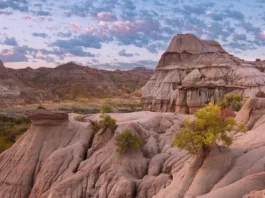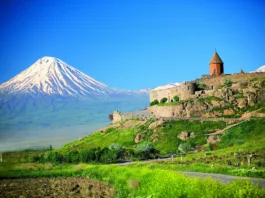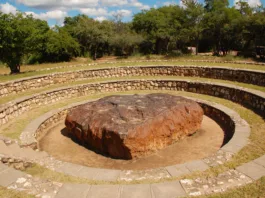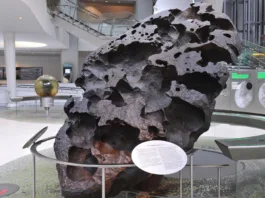Brimham Rocks is a fascinating natural rock formation located in North Yorkshire, England. It is a collection of unique and striking rock formations that have captured the imagination of visitors for centuries. These rocks, characterized by their bizarre shapes and balancing acts, have become a popular tourist attraction and an important geological site.



Brimham Rocks is situated within the Nidderdale Area of Outstanding Natural Beauty, near the village of Summerbridge. The site covers around 50 acres and is managed by the National Trust. Its significance lies in its remarkable and distinctive rock formations, which have been sculpted by natural forces over millions of years. The rocks are not only visually captivating but also hold geological and historical importance.
Geological Origins and Formation Process:
The unique rock formations at Brimham Rocks have their origins in the distant geological past, shaped by a combination of processes including weathering, erosion, and glaciation. Here’s an overview of the formation process:
- Sedimentary Deposition: Around 320 million years ago, during the Carboniferous period, the region was covered by a shallow sea. Over time, layers of sediment, including sandstone and shale, were deposited.
- Tectonic Activity: Subsequent tectonic activity, including uplift and folding of the Earth’s crust, led to the formation of a range of hills in the area, including Brimham Moor.
- Weathering and Erosion: The exposed rocks on Brimham Moor were subjected to various weathering processes, including freeze-thaw cycles, which caused the expansion and contraction of water within cracks, gradually breaking down the rocks. Wind, rain, and other erosional forces also played a role in shaping the rocks.
- Glacial Action: During the last Ice Age, which occurred around 18,000 years ago, glaciers covered much of northern England. The movement of these glaciers over the landscape further shaped the rocks through processes like plucking and abrasion. Glacial meltwater also carved out valleys, exposing the unique formations we see today.
- Differential Erosion: Different layers of rock have varying resistance to erosion due to differences in hardness and composition. This led to the formation of the distinctive shapes and balancing formations that are characteristic of Brimham Rocks.
The end result of these processes is an array of bizarre and gravity-defying rock formations, including balancing rocks, pinnacles, and arches. The most iconic formations, such as the “Dancing Bear” and the “Eagle,” continue to capture the imagination of visitors and geologists alike.
Brimham Rocks stands as a testament to the enduring power of natural forces to shape and create remarkable features in the landscape. It offers a glimpse into the Earth’s dynamic geological history and provides a unique opportunity for visitors to marvel at the beauty and intricacy of the natural world.
Geological Features of Brimham Rocks

Brimham Rocks is renowned for its extraordinary and diverse rock formations, each exhibiting unique shapes that have captivated visitors for generations. These formations are the result of millions of years of geological processes, including erosion, weathering, and glacial activity. Here are some of the prominent rock formations and their characteristics:
- Balancing Rocks and Pinnacles: One of the most striking features of Brimham Rocks is the collection of balancing rocks and towering pinnacles. These formations are the result of differential erosion, where softer rock layers have eroded more quickly than harder layers, creating gravity-defying structures. The rocks seem to delicately balance on top of each other, defying the forces of nature. The “Eagle,” for example, resembles a bird with outstretched wings, while the “Dancing Bear” looks like a bear on its hind legs.
- Mushroom Rock: This formation is characterized by a large, flat boulder perched atop a narrower stem, resembling a mushroom. The stem is often eroded at the base, contributing to the distinct shape. It’s a classic example of erosion and differential weathering, where the softer base of the rock has eroded faster than the harder top.
- Rock Gorge and Chasms: Brimham Rocks also features narrow rock gorges and chasms carved by glacial meltwater and erosion. These features provide a glimpse into the powerful processes that shaped the landscape during the last Ice Age. Visitors can walk through these chasms and experience the unique formations up close.
- Cannon Rock: This formation resembles a cannon, with a large round boulder perched atop a narrow base. Like other formations, Cannon Rock is a product of selective erosion, where the softer rock underneath has worn away faster than the harder rock on top.
- Sphinx Rock: Resembling the mythical creature, the Sphinx Rock consists of a large, elongated boulder balanced on a smaller base. Its distinct shape is a result of differential weathering, emphasizing the contrast between the harder and softer rock layers.
- Idol Rock: Idol Rock is an impressive pillar-like formation with a more massive upper section balanced on a smaller pedestal. It showcases the dynamic interplay between the forces of erosion and the resilience of the rock layers.
Types of Rocks and Characteristics:
The rock formations at Brimham Rocks are primarily composed of millstone grit, a type of sandstone. Millstone grit is known for its durability and resistance to weathering, making it suitable for forming the intricate and gravity-defying shapes seen at the site. Some key characteristics of millstone grit include:
- Composition: Millstone grit is composed of sand grains and other minerals cemented together by natural agents like silica. The rock’s coarse texture is due to the relatively large size of its sand grains.
- Hardness: Millstone grit is a relatively hard rock, which has contributed to the formation of the unique shapes and balanced structures seen at Brimham Rocks. Harder layers erode more slowly than softer layers, resulting in the distinctive formations.
- Color: Millstone grit typically exhibits earthy tones, ranging from reddish-brown to gray. The variation in color can be attributed to differences in mineral content and oxidation.
- Resistance to Erosion: The hardness and durability of millstone grit have enabled the formation of Brimham Rocks’ intricate shapes over time. The rock’s resistance to erosion has allowed some portions to stand tall while surrounding areas eroded away.
Brimham Rocks’ geology and its intricate formations offer a remarkable opportunity to study the effects of natural processes on the landscape, showcasing the enduring beauty and complexity of the Earth’s geological history.
Formation and Erosion of Brimham Rocks

The formation of Brimham Rocks is a testament to the gradual yet powerful forces of erosion and weathering that have shaped the landscape over millions of years. The intricate and distinctive shapes of the rock formations are the result of a complex interplay between various natural agents, including wind, water, and ice.
Weathering: Weathering is the process by which rocks are broken down into smaller particles due to exposure to atmospheric conditions. In the case of Brimham Rocks, the process of weathering played a crucial role in shaping the initial rock layers and creating the conditions for further erosion. Over millions of years, cycles of heating and cooling, along with freeze-thaw action, caused cracks to develop in the rock layers.
Erosion: Erosion is the process by which rocks and soil are worn away and transported by natural agents such as wind, water, and ice. At Brimham Rocks, erosion acted in concert with weathering to sculpt the unique formations we see today.
- Water Erosion: Rainwater, flowing over the exposed rock surfaces, carried away loose particles and sediment. As water seeped into cracks and pores in the rocks, it froze during colder periods, exerting pressure and causing the rocks to crack further. This freeze-thaw action contributed to the gradual breakdown of the rocks and the formation of crevices and gaps.
- Wind Erosion: Wind is another significant agent of erosion. It carried fine sand and dust particles, which, over time, abraded the rock surfaces and contributed to the smoothing of the rocks’ edges. Wind erosion played a role in refining the shapes of the formations and creating the distinct features seen today.
- Ice Erosion (Glaciation): The last Ice Age, which occurred around 18,000 years ago, had a profound impact on the landscape of Brimham Rocks. Glaciers advanced and retreated, carving out valleys and shaping the rocks through processes such as plucking and abrasion. Glacial meltwater also contributed to the formation of chasms and gorges, exposing the intricate layers of rock.
Differential Erosion: One of the key factors in the formation of Brimham Rocks’ unique shapes is differential erosion. The rocks consist of alternating layers of harder and softer materials. Harder layers, such as millstone grit, eroded more slowly than the softer layers, leading to the creation of balancing rocks, pinnacles, and other gravity-defying formations. This selective erosion highlighted the contrasts between the various rock layers and emphasized the distinctive shapes.
Over millions of years, these processes of weathering and erosion sculpted the landscape, creating the visually captivating and iconic formations that continue to draw visitors to Brimham Rocks. The delicate dance between the forces of nature shaped the rocks into intricate sculptures, each telling a story of the Earth’s dynamic history and the enduring power of natural processes.
How to Visit

Visiting Brimham Rocks can be a wonderful experience, allowing you to explore the unique rock formations and immerse yourself in the natural beauty of the area. Here’s a guide on how to visit Brimham Rocks:
1. Plan Your Trip:
- Check the opening hours and admission fees: Before you go, make sure to check the official website or contact the site management to find out the current opening hours and any admission fees that may apply.
- Weather conditions: Brimham Rocks is an outdoor attraction, so be sure to check the weather forecast before your visit and dress accordingly.
- Facilities: Take note of the facilities available on-site, such as parking, restrooms, visitor center, and any guided tours or activities.
2. Getting There:
- By Car: Brimham Rocks is accessible by car. Use GPS or navigation apps to find the best route from your location.
- Public Transportation: Depending on your location, you might be able to use public transportation to get close to Brimham Rocks, followed by a short taxi or walking trip.
3. Exploring Brimham Rocks:
- Walking Trails: There are several well-marked walking trails that allow you to explore the rock formations and the surrounding landscape. Trails vary in length and difficulty, so choose one that suits your preferences and fitness level.
- Photography: Brimham Rocks offers fantastic opportunities for photography, so don’t forget to bring your camera or smartphone to capture the stunning landscapes and unique rock formations.
4. Safety and Respect:
- Stay on designated paths: To protect the fragile ecosystem and ensure your safety, stick to the designated walking paths and avoid climbing on the rocks.
- Safety precautions: Some of the formations may require caution when approaching or exploring due to their balance and height. Always follow any posted safety guidelines and be aware of your surroundings.
- Leave no trace: Respect the environment by not littering and disposing of waste properly. Leave the site as you found it to preserve its natural beauty.
5. Visitor Center:
- Visitor Information: Stop by the visitor center, if available, to gather information, maps, and learn about the geology and history of Brimham Rocks.
- Guided Tours: Check if there are any guided tours or educational programs offered by the visitor center. These tours can provide valuable insights into the site’s geological and cultural significance.
6. Nearby Attractions:
- Explore the surroundings: Brimham Rocks is located in the Nidderdale Area of Outstanding Natural Beauty, so consider exploring nearby attractions, villages, and natural sites.
Remember that conditions and offerings may change, so it’s a good idea to check the official website or contact the site management before your visit to get the most up-to-date information. Enjoy your visit to Brimham Rocks and take the time to appreciate the awe-inspiring geological wonders that have been shaped over millions of years.






